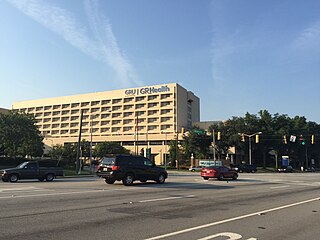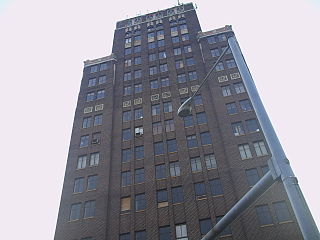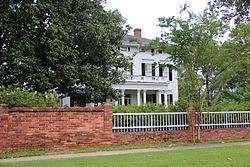
Augusta, officially Augusta–Richmond County, is a consolidated city-county on the central eastern border of the U.S. state of Georgia. The city lies across the Savannah River from South Carolina at the head of its navigable portion. Georgia's third-largest city after Atlanta and Columbus, Augusta is located in the Fall Line section of the state.
This article is about the many neighborhoods and districts in the Greater Richmond, Virginia area. Note that this article is an attempt to be inclusive of the broader definitions of the areas which are often considered part of the Greater Richmond Region, based on their urban or suburban character and nature, rather than by strictly political boundaries.

The Sweet Auburn Historic District is a historic African-American neighborhood along and surrounding Auburn Avenue, east of downtown Atlanta, Georgia, United States. The name Sweet Auburn was coined by John Wesley Dobbs, referring to the "richest Negro street in the world," one of the largest concentrations of African-American businesses in the United States.

John Milledge was an American politician. He fought in the American Revolution and later served as United States Representative, 26th Governor of Georgia, and United States Senator. Milledge was a founder of Athens, Georgia, and the University of Georgia. From January to May 1809, Milledge served briefly as President pro tempore of the United States Senate.

Augusta University (AU) is a public research university and academic medical center in Augusta, Georgia. It is a part of the University System of Georgia and has satellite medical campuses in Savannah, Albany, Rome, and Athens. It employs over 15,000 people, has more than 56,000 alumni, and is accredited by the Southern Association of Colleges and Schools.

Downtown Jacksonville is the historic core and central business district (CBD) of Jacksonville, Florida USA. It comprises the earliest area of the city to be developed and is located in its geographic center along the narrowing point of the St. Johns River. There are various definitions of what constitutes Jacksonville's downtown; the one used by the city government and other entities defines it as including eight districts: the Central Core, the Southbank, LaVilla, Brooklyn, the Working Waterfront, the Cathedral, the Church, and the Entertainment & Sports District. The area features offices for major corporations such as CSX Corporation, Fidelity National Financial, TIAA Bank, Black Knight Financial, One Call Care Management, Suddath, Interline Brands Haskell, FIS, and Stein Mart.

Wick Park Historic District is a historic neighborhood on the north side of Youngstown, Ohio, with Wick Park as its centerpiece. During the first half of the 20th century, the residential district surrounding Wick Park included some of the city's most affluent neighborhoods. The district is "roughly bounded by 5th Ave, Park Ave, Elm St. and Broadway".
The City of Oklahoma City uses Special Zoning Districts as a tool to maintain the character of many neighborhood communities.

The Medical District of Augusta, Georgia, is a special-use zoning district located between downtown and Summerville. The district is bounded to the north by Walton Way, to the east by R.A. Dent Boulevard, to the west by Heard Avenue, and to the south by Wrightsboro Road. The district comprises a number of medical facilities and private medical companies.

The Stephen Vincent Benét House, commonly referred to as Benét House, is a historic house on the Summerville campus of Augusta University in Augusta, Georgia. The house was built 1827–29 as the Commandant's House of the Augusta Arsenal, and is a much-altered example of Federal period architecture. The house was designated a National Historic Landmark in 1971 for its association with the Pulitzer Prize-winning writer Stephen Vincent Benét (1898–1943), who lived here in the 1910s. The house, which housed the official residence of the Augusta State University for a time, presently houses the Summerville campus's office of admissions.

Meadow Garden is a historic house museum at 1320 Independence Drive in Augusta, Georgia. It was a home of Founding Father George Walton (1749–1804), one of Georgia's three signers of the U.S. Declaration of Independence, and later a governor of Georgia and a United States senator. Meadow Garden was saved and established as a museum by the Daughters of the American Revolution in 1901. It was declared a National Historic Landmark in 1981.

The history of Meridian, Mississippi begins in the early 19th century before European-American settlement. Originally settled by the Choctaw Indians, the land was bought by the United States according to the Treaty of Dancing Rabbit Creek in 1830. The city grew around the intersection of the Mobile and Ohio Railroad and the Southern Railway of Mississippi and developed a largely rail-based economy. Although much of the city was burned down in the Battle of Meridian during the American Civil War, the city was rebuilt and entered a "Golden Age." Between about 1890 and 1930, the city was the largest in Mississippi and a leading center for manufacturing in the Southern United States. After the decline of the railroading industry in the 1950s, the city's economy was devastated, resulting in a slow population decline. The population has continued to decline as the city has struggled to create a new, more modern economy based on newer industries. In the past 20 years or so, Meridian has attempted to revitalize the city's economy by attracting more business and industry to the city, most specifically the downtown area.

Augusta Downtown Historic District is a historic district that encompasses most of Downtown Augusta, Georgia and its pre-Civil War area.
Winnona Park is a historic area in the southeast corner of the Atlanta, Georgia suburb of Decatur. It is listed as a historic district on the National Register of Historic Places, but it is not one of the City of Decatur's locally designated historic districts.

William Lee Stoddart (1868–1940) was an architect best known for designing urban hotels in the eastern United States. Although he was born in Tenafly, New Jersey, most of his commissions were in the South. He maintained offices in Atlanta and New York City.

There are nine historic districts in Meridian, Mississippi. Each of these districts is listed on the National Register of Historic Places. One district, Meridian Downtown Historic District, is a combination of two older districts, Meridian Urban Center Historic District and Union Station Historic District. Many architectural styles are present in the districts, most from the late 19th century and early 20th century, including Queen Anne, Colonial Revival, Italianate, Art Deco, Late Victorian, and Bungalow.

The Augusta Arsenal was a 19th-century fortification in Augusta, Georgia. Established in 1816 and initially completed on the Georgia bank of the Savannah River in 1819, it was moved to the former Belle Vue estate in the Summerville neighborhood of Augusta in 1827 due to health concerns after several fever epidemics.
Albert Anthony Ten Eyck Brown (1878–1940) was an architect active in Atlanta, Georgia and other areas. Brown was born in Albany, New York. He studied at the New York Academy of Design.

The Sand Hills Historic District in Augusta, Georgia is a historic district which was listed on the National Register of Historic Places in 1997. The district included 334 contributing buildings and a contributing site in a 231 acres (0.93 km2) area roughly bounded by Monte Sano and North View Aves., Mount Auburn St., Johns Rd., and the Augusta Country Club.

The Partridge Inn, in Augusta, Georgia, is a hotel in the Curio Collection by Hilton. Its current full name is The Partridge Inn Augusta, Curio Collection by Hilton.























